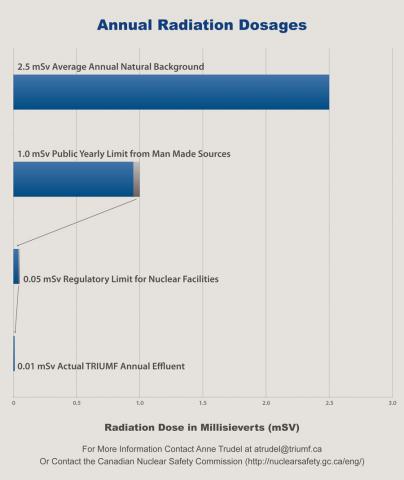The operation of an accelerator results in low levels of short-lived radioactivity created right near the device itself as a by-product of the acceleration process. Maintaining particle beams is a delicate operation, and they turn off instantly when disrupted (such as in electrical-power fluctuations), not unlike opening the door of your microwave oven. The laboratory has developed a sophisticated system of interlocks and safety procedures to protect workers and the environment.
In addition to its own extensive safety program, TRIUMF is regulated by the Canadian Nuclear Safety Commission, which oversees nuclear safety in Canada. The Safety Commission has designated TRIUMF as a Class I-B facility because of the intensity of the beams produced by the cyclotron, not because of any significant inventory of radioactive material on site.
 Radioactivity is the spontaneous decay of the core (nucleus) of an atom, emitting energy in the form of particles or electromagnetic waves. Radiation is measured in units called microsiveverts (μSv) that measures the biological impact of the energy deposited into tissue.
Radioactivity is the spontaneous decay of the core (nucleus) of an atom, emitting energy in the form of particles or electromagnetic waves. Radiation is measured in units called microsiveverts (μSv) that measures the biological impact of the energy deposited into tissue.
Radiation is a natural phenomenon, arising from cosmic rays that originate in the upper atmosphere and from radioactive isotopes in the ground. The naturally occurring level in Vancouver is 1,400 μSv per year. In contrast, the research work conducted at TRIUMF contributes less than 10 μSv per year to a person living next door to the site. One also gets radiation exposure during airplane travel. Radiation exposure increases during plane flights because at high altitudes there is less atmosphere to shield cosmic rays. A 4-hour flight from Vancouver to Toronto can add as much as 16 μSv of radiation exposure.
TRIUMF conducts a comprehensive environmental monitoring program to maintain an ongoing record of environmental quality around the facility. These records are reviewed by the federal regulators and are publicly available. These practices ensure that all harmful by-products of the research are closely controlled. The program includes monitoring of air, water, soil, and vegetation.
The radioactivity that occurs at TRIUMF is principally located in the main cyclotron, which is extremely well sealed. The cyclotron is located underground and is shielded by three staggered layers of 50-tonne concrete blocks, each 1.5 metres thick. Access is gained only when the cyclotron is turned off through a series of interlocking doors.
The small quantities of short-lived solid radioactive by-products are stored for a lengthy period in special containers. This allows the radioactive levels to decay and drop to natural or hard-to-detect levels. Before release, all products are checked to ascertain the level of radioactivity present. Remaining low-level material is shipped out about once per year using tightly regulated and monitored procedures.
Radioactive materials are used in medicine and are called medical isotopes. TRIUMF produces some medical isotopes for use in the Vancouver area. A special underground, sealed transport line carries small quantities of medical-isotope doses from TRIUMF to the UBC hospital.
Externally reviewed reports show that air and water quality remain consistent with conditions recorded before the facility began operation nearly 35 years ago. Samples of storm-sewer water and vegetation taken regularly at eight cardinal locations around the site show no effect on groundwater or surface water quality. Findings over the past eight years show that the radioactivity is far less than 1% of the annual regulatory limit (see graph above for reference). In other words, these extremely low findings show TRIUMF to be an environmentally good neighbour.
